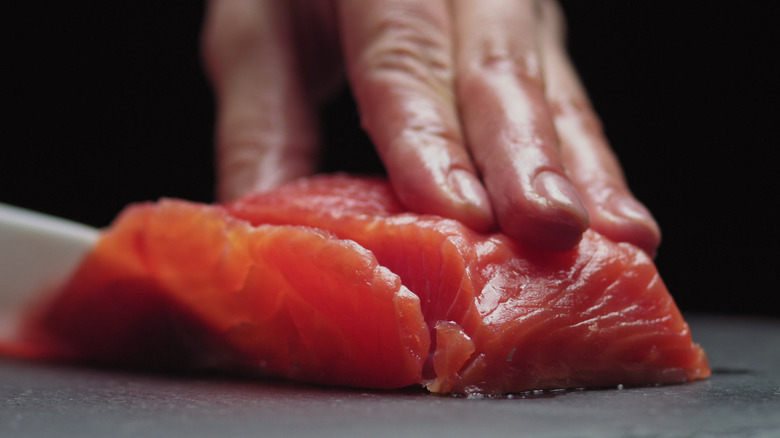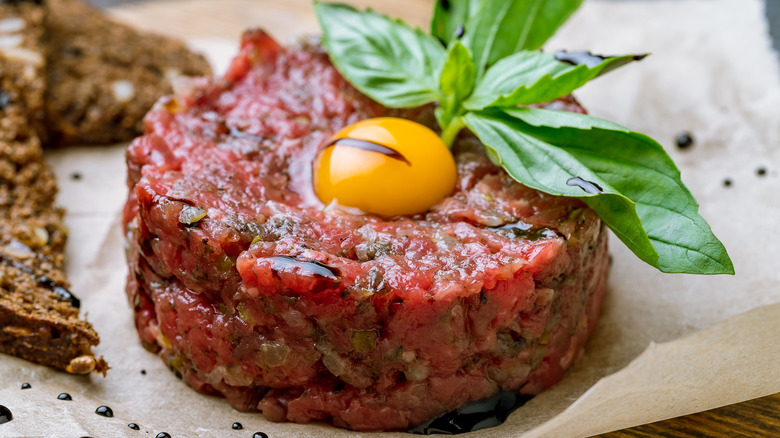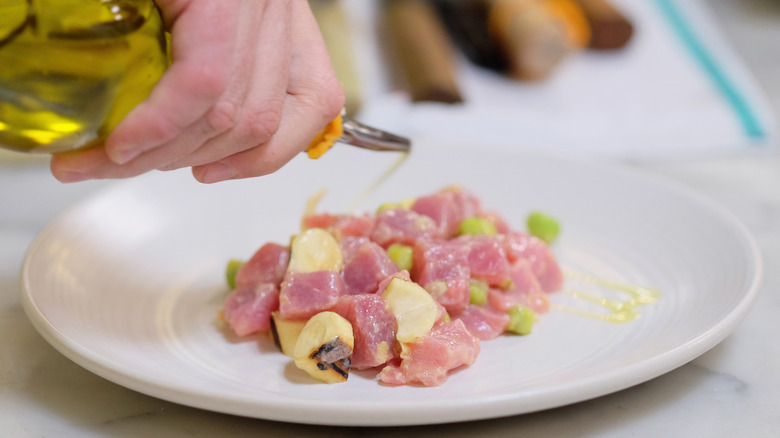What's The Difference Between Tartare And Crudo?
Although consuming raw meat has its risks, it's a practice that is widespread throughout the world when prepared correctly, per Food Authority. In the Netherlands, a raw, richly flavored beef sausage called ossenworst is consumed with regularity. Over in Thailand, koi soi is an immensely popular raw beef salad that is marinated in a classic southeast Asian combination of fish sauce, garlic, lime juice, and assorted herbs (via Great British Chefs).
And of course, there are the usual suspects like the Japanese traditions of sashimi and sushi, Italy's iconic thin sliced beef carpaccio and crudo, and France's equally seminal steak tartare, as noted by Bon Appétit. As for the last two, tartare and crudo — they may seem quite similar. Both are served intentionally raw, involve a certain amount of preparation such as cutting up and seasoning the meat, and are sourced with ingredients of the highest quality.
However, apart from their distinct origins, these two dishes are even more different than they appear. Evident in tartare and crudo are ingredients and methods which, once known, will make it all but impossible to confuse one for the other ever again.
Tartare can be made with various meat and takes on a certain shape
The fact that steak tartare is considered something of a luxury food item has absolutely everything to do with the French — both in origin and preparation. Originally called beefsteak à l'Américaine because the French seemed to think the American diet consisted solely of red meat, tartare began appearing in bistros across Paris during the late 19th century. Though the original meat for tartare was believed to be from a horse, high-quality beef soon became the go-to, and the recipe evolved from there (via Britannica).
The Michelin Guide explains that the tartare moniker came from the fact that cooks started serving the meat with a side of tartar sauce, which is omitted from most modern renditions. To prepare steak tartare, you can dress the meat with a number of different sauces to add levels of flavor. According to MasterClass, the minced beef — which should be from a nice cut of meat — can be mixed with Worcestershire sauce. However, Tabasco, ketchup, or cognac are great additions to the mixture as well, per Britannica.
Anchovies, capers, and alliums (flowering onions) are the next ingredients to be added to the meat and sauce and then packed into a ring mold. A raw egg yolk is placed on top, accompanied by cornichon pickles and baguette slices on the side. If you're wanting a more filling option, fried potatoes can also be served with the dish as an alternative.
And if you aren't a fan of minced steak, tuna tartare with shallots or salmon with beets and avocado are excellent substitutes to try (via Great British Chefs). Just remember: If it comes to you ring-shaped, raw, and there's an egg yolk nearby, it's mostly likely a tartare.
Crudo has minimal ingredients and can be presented in many ways
The polar opposite of tartare in terms of ingredients and flavors is crudo. According to The New Yorker, the appeal of eating raw meat is that the subtlety of the flavors lingers for a long time on the palate, which the Italians have mastered with crudo. When compared to the heavily seasoned tartare, crudo seems almost laughably simple.
It consists of the following: raw fish, lemon juice, salt, and good olive oil. Short for "pesce crudo," meaning raw fish, crudo originated from the coast of Italy and is not to be confused with carne cruda, a raw beef salad similar to steak tartare but without all the trappings (via the Michelin Guide).
There isn't a definitive answer to exactly when eating raw fish started in Italy, but it's an ingrained part of the coastal culture nonetheless. According to Food Republic, despite the minimal ingredients, crudo is still reliant on one ingredient to coax out flavor: the olive oil. It needs to be of outstanding quality since the acidity brings a subtle and smooth richness that won't cure or overpower the thin fish.
Crudo can be served as is or with an assortment of garnishes like slices of blood orange, almonds, and various herbs such as oregano or basil, states Great Italian Chefs. And unlike tartare's typical circular shape, crudo is presented and plated in various fashions with its garnishings.
Despite their differences, what tartare and crudo seem to hold in common is culinary tradition — both of which celebrate the primary ingredients of raw meat in unique, tasty ways.


